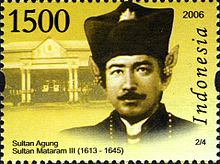Mataram conquest of Surabaya
| Mataram conquest of Surabaya | |||||||
|---|---|---|---|---|---|---|---|
| |||||||
| Belligerents | |||||||
|
|
Duchy of Surabaya
| ||||||
| Commanders and leaders | |||||||
|
Sultan Agung of Mataram
|
| ||||||
The Mataram conquest of Surabaya or Mataram-Surabaya War was a military campaign by the
Background
In the latter half of the 16th century, the
The
Campaign
Conquest of Surabaya's allies


In 1613
The conquest of the strategically important Wirasaba posed such a clear threat to Surabaya and other eastern states that the alliance rallied. They mobilized their troops and marched towards Pajang, a city under Mataram's control but ostensibly on the verge of rebellion.[14] However, a Mataram spy in Tuban deceived the allied forces into taking a bad route towards Pajang. As a result, the allied army found itself isolated in Siwalan, near Pajang. This army was surrounded by Sultan Agung and defeated in January 1616.[14]
Agung then won victories in Lasem (1616) and Pasuruan (1616–17). In 1617 Pajang finally rebelled against Mataram but was defeated, and the lord of Pajang fled to Surabaya.[14] In 1619 Agung conquered Tuban, one of the strongest members of Surabaya's alliance.[14] This conquest put Agung in control of Tuban's shipbuilding activities, and therefore allowed him to build a navy to challenge Surabaya's previous naval supremacy.[14]
Sieges of Surabaya
By 1620, Mataram's main target shifted towards the city of Surabaya itself. From 1620 to 1625, Mataram forces periodically besieged Surabaya.
Mataram sent five expeditions to attack Surabaya.[16] The first, in 1620, involved 70,000 Mataram troops against Surabaya's 30,000,[17] but the siege failed due to insufficient supplies for the Mataram troops.[17] The second attempt in 1622 also failed due to lack of food supplies.[17] The third attempt in 1623 also failed to conquer Surabaya.[18] Mataram besieged Surabaya again in 1624, occupying and pillaging the surrounding settlements and forcing their residents to flee to the city.[18] At the same time, Mataram also sent expeditions against Surabaya's remaining allies, notably Sukadana in Borneo, which fell in 1622, and Madura, which fell in 1624.[14] These two overseas allies had been supplying Surabaya, and their defeat severely cut off the city.[14]
The fifth and final siege took place in 1625, and Mataram troops were led by
Jayalengkara became Sultan Agung's vassal in Surabaya, and the elderly duke
Aftermath
The conquest eliminated Mataram's strongest rival to the east and allowed Sultan Agung to establish his sovereignty over most of the
This conquest marked the maximum extent of Mataram's power.[2] Having consolidated his power in central and eastern Java, Agung then turned westward to deal with the Dutch. His army attacked Batavia in 1628, and again in 1629, but these campaigns ended in a devastating defeat.[23] After this failure, Mataram expansion stopped, and it would no longer be a threat to either Banten or the Dutch.[24]
In addition, the campaign resulted in some destruction, especially along the Javanese northern coast.
References
Footnotes
- ^ a b Akhmad Saiful Ali 1994, p. 64.
- ^ a b c d e f g h i j Ricklefs 2008, p. 48.
- ^ a b c d e f g h Ricklefs 2008, p. 46.
- ^ Syed, Akhtar & Usmani 2011, p. 337.
- ^ a b Ricklefs 2008, p. 116.
- ^ Ricklefs 2008, p. 41.
- ^ Ricklefs 2008, p. 38.
- ^ Akhmad Saiful Ali 1994, p. 33.
- ^ a b c Ricklefs 2008, p. 45.
- ^ Akhmad Saiful Ali 1994, p. 28.
- ^ Akhmad Saiful Ali 1994, p. 34.
- ^ a b c d Akhmad Saiful Ali 1994, p. 35.
- ^ Akhmad Saiful Ali 1994, p. 47.
- ^ a b c d e f g h i j k Ricklefs 2008, p. 47.
- ^ Pigeaud 1976, p. 39.
- ^ a b c d e Akhmad Saiful Ali 1994, p. 58.
- ^ a b c Akhmad Saiful Ali 1994, p. 60.
- ^ a b Akhmad Saiful Ali 1994, p. 62.
- ^ a b c d e Akhmad Saiful Ali 1994, p. 65.
- ^ a b Pigeaud 1976, p. 40.
- ^ Akhmad Saiful Ali 1994, p. 66.
- ^ Hefner 1990, p. 29.
- ^ Ricklefs 2008, p. 49.
- ^ Ricklefs 2008, p. 50.
- ^ Akhmad Saiful Ali 1994, pp. 77–78.
- ^ Kratoska 2001, p. 113.
Bibliography
- Hefner, Robert W. (January 1990). Hindu Javanese: Tengger Tradition and Islam. Princeton University Press. ISBN 978-0-691-02856-9.
- Kratoska, Paul H. (2001). South East Asia, Colonial History: Imperialism before 1800. Taylor & Francis. ISBN 978-0-415-21540-4.
- ISBN 978-1-137-05201-8.
- ISBN 978-90-247-1876-4.
- Akhmad Saiful Ali (1994). Ekspansi Mataram terhadap Surabaya Abad ke-17 (Thesis) (in Indonesian). Surabaya: Islamic Institute of Sunan Ampel.
- Syed, Muzaffar Husain; Akhtar, Syed Saud; Usmani, B. D. (2011-09-14). Concise History of Islam. Vij Books India Pvt Ltd. pp. 336–337. ISBN 978-93-82573-47-0.
